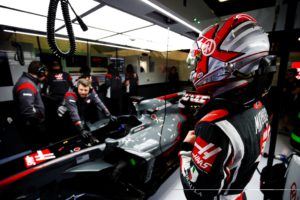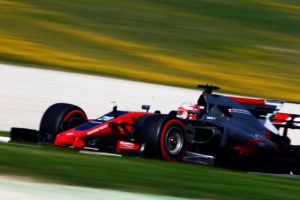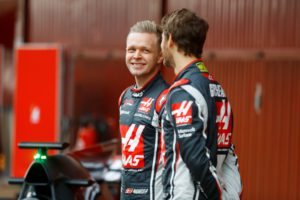Kevin Magnussen explains how his first test with Haas went as well as his expectations for the Australian Grand prix.
Haas F1 Team tested at Barcelona for eight days over a 12-day span. How did it go and how did it prepare you for Australia?
“I think it went well. On my days I got a lot of laps, lots of kilometers, and some very good testing done. It was good to learn about the car, especially this year with the cars being very different to last year. It was very useful. Now I’m just waiting to get back in the car in Australia and get racing again.”

How would you describe the VF-17?
“I think it’s fast. The first impression you get when you drive it is how much grip there is. The thing about this year is that everyone has gained a lot of grip and I’m sure everyone had that impression when they got back in their cars. Hopefully, we’ll be competitive. Hopefully, it’s a car that we can work with and improve over the year. The first feelings are positive.”
Much has been made about how physical these new cars are to drive. After testing in Barcelona, how did your body feel?
“After the first day it was a bit tough. I could definitely feel my neck. After my second day, and for the rest of the test, I was fine. It’s good to feel that the work had paid off and that I’m fit enough to race. I’ll keep working, and I’m even more motivated to train now that I can feel the difference. That’s really good.”
Was there any particular area of your body where you felt the effects of increased g-forces?
“The neck was the big one. I could even feel it in my legs, keeping my knees apart, and just keeping my legs upright. That was certainly something I’ve never felt before through the corners. My glutes were being worked in the car, which was something completely new. It’s good to feel that. It’s what we want. We want to go fast and we want to be pushing the car hard. These cars allow that.”
Tires are 25 percent wider this year, but have you noticed any change in the characteristics of the various tire compounds or have they remained consistent from last year?
“It’s still a little early. It’s hard to even say after the test in Barcelona because the temperatures were not representative of a lot of the races we’ll do. Some will be a little cold, but I guess in Australia we could be in a situation where temperatures will be the same as Barcelona. In that case, the tires are going to behave well. They are durable and you can push them hard. You can push relatively hard for a whole stint. We’ll see when we get to the hotter races how the tires behave.”

With lap times coming down by roughly five seconds, where is the time being found? Corner entry? Corner exit? Both?
“It’s both. It’s from when you hit the brakes to going full throttle. That’s the place we’re gaining the time. You could say we’re gaining more than those five seconds in the corners because we’re then losing time on the straights compared to last year. We have to gain more than those five seconds back in the corners. It’s pretty impressive.”
You have the honor of being the only person to have sampled each current Formula One engine supplier – Mercedes and Honda with McLaren, Renault with Renault Sport F1 and now Ferrari with Haas F1 Team. How does the Ferrari 062 feel compared to those other engines?
“To be honest, none of the engines feel very different. They all seem pretty similar. They sound a bit different, and operationally they’re slightly different engine to engine, but the Ferrari is very easy to work on. It’s easy to understand and the drivability is very good. Also, the power seems to be good this year, so I’m very happy.”
Speed is obviously the name of the game in racing. But with new cars built under new regulations, how important is reliability, particularly at the start of the season?
“It’s important every race. Reliability is number one. You need to be able to finish a race, and then you can make it perform well after that. We were reliable in testing. We didn’t have any big issues with the power unit at all in testing, and neither did Ferrari. I think that’s a good sign and the power seems to be good as well. No complaints.”
Haas F1 Team had a remarkable debut last year in the Australian Grand Prix. And in 2014, you also had a remarkable Formula One debut at Australia, starting fourth and finishing second to Nico Rosberg. How were you able to achieve such a strong result in your first Formula One race?
“I think I just went into it with a smile and enjoyed it. Didn’t really think too much about the race. I had nothing to lose and just went for it. I drove at my best, had a bit of luck as well, and I ended up on the podium. It was a great experience and a memory I will have forever. It’s always going to be quite cool to say that I finished second in my first Formula One race, although it would have been nice to win. I’ll do that another time.”
How important is it to start the year with some point-paying finishes?
“It’s always important to have a good start to the year just to kick-start everything. It gives you a boost to have a good beginning. The end is important too, but it’s always nice to start off the year with a good race. We’ll do our best and see what we get.”

What are your goals for the season-opening race in Australia?
“My goal for the season, and it’s the same for the team, is to try and improve on the result from last year, which was very good. Going on to then finish eighth in the constructors championship, with 29 points, was a great result for a first-year Formula One team. To improve on that, even just a little bit, would be a good target.”
What is your favorite part of the Albert Park Circuit?
“I think turns one and two are quite cool. I also like the faster bits like turns eight and nine, and through the big chicane.”
Explain a lap around the Albert Park Circuit.
“It’s a bumpy track, especially at turn one, which makes it a bit difficult to brake late. If you don’t lock up there, that’s the first step to a good lap. You then have a slow section through turns three, four and five. Braking there is always tricky. You have a lot of shadows from the trees around the park. Finding your braking point is always difficult. You start going faster on the back. You have the big chicane and then, finally, you finish off the lap with a difficult section, including tricky slow corners through (turns) 14, 15 and 16.”
































